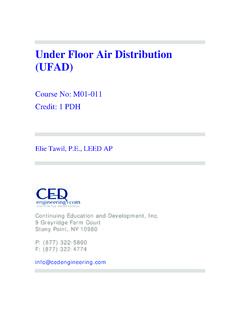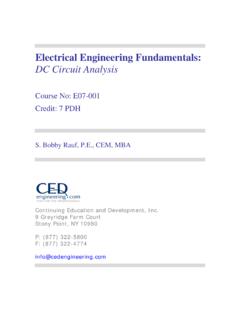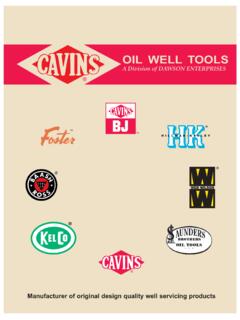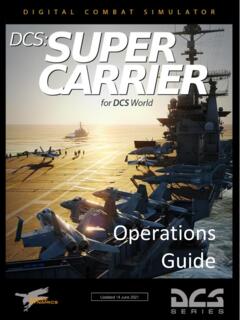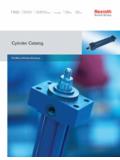Transcription of Principles of Hydraulic and Pneumatic Systems
1 Principles of Hydraulic and Pneumatic Systems Course No: M04-043 Credit: 4 PDH Elie Tawil, , LEED AP Continuing Education and Development, Stonewall CourtWoodcliff Lake, NJ 07677P: (877) 14264A 9-1 Chapter 9 Hydraulic and Pneumatic Systems Topic Hydraulic Systems Pneumatic Systems Overview In automotive and construction equipment, the terms Hydraulic and Pneumatic describe a method of transmitting power from one place to another through the use of a liquid or a gas. Certain physical laws or Principles apply to all liquids and gases. This chapter covers the basic Principles associated with hydraulics and pneumatics, followed by coverage of various system components. The purpose of this information is to give you an analytical understanding of the interrelationships of Principles and the components of Hydraulic and Pneumatic operating Systems .
2 Objectives When you have completed this chapter, you will be able to do the following: 1. Understand the operating Principles of Hydraulic Systems . 2. Identify operational characteristics, component functions, and maintenance procedures of a Hydraulic system. 3. Understand the operating Principles of a Pneumatic system. 4. Identify operational characteristics and service procedures applicable to heavy- duty compressors. NAVEDTRA 14264A 9-2 Prerequisites This course map shows all of the chapters in Construction Mechanic Basic. The suggested training order begins at the bottom and proceeds up. Skill levels increase as you advance on the course map. Automotive Chassis and Body C M B A S I C Brakes Construction Equipment Power Trains Drive Lines, Differentials, Drive Axles, and Power Train Accessories Automotive Clutches, Transmissions, and Transaxles Hydraulic and Pneumatic Systems Automotive Electrical Circuits and Wiring Basic Automotive Electricity Cooling and Lubrication Systems Diesel Fuel Systems Gasoline Fuel Systems Construction of an Internal Combustion Engine Principles of an Internal Combustion Engine Technical Administration Features of this Manual This manual has several features which make it easy to use online.
3 Figure and table numbers in the text are italicized. The figure or table is either next to or below the text that refers to it. The first time a glossary term appears in the text, it is bold and italicized. When your cursor crosses over that word or phrase, a popup box displays with the appropriate definition. Audio and video clips are included in the text, with italicized instructions telling you where to click to activate it. Review questions that apply to a section are listed under the Test Your Knowledge banner at the end of the section. Select the answer you choose. If the answer is correct, you will be taken to the next section heading. If the NAVEDTRA 14264A 9-3 answer is incorrect, you will be taken to the area in the chapter where the information is for review. When you have completed your review, select anywhere in that area to return to the review question.
4 Try to answer the question again. Review questions are included at the end of this chapter. Select the answer you choose. If the answer is correct, you will be taken to the next question. If the answer is incorrect, you will be taken to the area in the chapter where the information is for review. When you have completed your review, select anywhere in that area to return to the review question. Try to answer the question again. NAVEDTRA 14264A 9-4 Hydraulic Systems The extensive use of hydraulics to transmit power is due to the fact that a properly constructed Hydraulic system possesses a number of favorable characteristics: A Hydraulic system eliminates the need for complicated Systems using gears, cams, and levers. Motion can be transmitted without the slack inherent in the use of solid machine parts. The fluids used are not subject to breakage as are mechanical parts.
5 Hydraulic system mechanisms are not subjected to great wear. If the system is well adapted to the work it is required to perform and is not misused, it can provide smooth, flexible, uniform action free of vibration and unaffected by variation of load. Hydraulic Systems can provide widely variable motions in both rotary and straight-line transmission of power. The need for control by hand can be minimized. In addition, they are economical to operate. Basic Principles of Hydraulics The basic Principles of hydraulics are few and simple: Liquids have no shape of their own. Liquids will NOT compress. Liquids transmit applied pressure in all directions. Liquids provide great increase in work force. Pascal's Law The foundation of modern hydraulics was established when Blaise Pascal, a French scientist, discovered the fundamental law for the science of hydraulics.
6 Pascal's law states that pressure applied to a confined liquid is transmitted undiminished in all directions and acts with equal force on all equal areas, at right angles to those areas. According to Pascal's law, any force applied to a confined fluid is transmitted in all directions throughout the fluid regardless of the shape of the container. Consider the effect of this in the Systems shown in Figure 9-1. If there is resistance on the output piston (View A, piston 2) and the input piston is pushed downward, a pressure is created through the fluid which acts equally at right angles to surfaces in all parts of the container. Figure 9-1 - Force transmitted from piston to piston. NAVEDTRA 14264A 9-5 Pascal's law is independent of the shape of the container; it is not necessary that the tubing connecting the two pistons be the full area of the pistons.
7 A connection of any size, shape, or length will do so long as an unobstructed passage is provided. Therefore, the system shown in View B (a relatively small, bent pipe connects the two cylinders) will act the same as that shown in View A. Pressure Pressure (P) is the amount of push or pull (force) applied to each unit area of the surface and is expressed in pounds per square inch (psi) or grams per square centimeter (gm/cm2). Pressure may be exerted in one direction, in several directions, or in all directions. Force Force (F) means a total push or pull. It is push or pull exerted against the total area of a particular surface and is expressed in pounds or grams. Area Area (A) represents the surface area acted upon by the Hydraulic force. Computing Force, Pressure, and Area The formula used to compute force, pressure, and area in a Hydraulic system can be described by force equals pressure times area and is written as: F=PxA.
8 Pressure equals force divided by area. By rearranging the above formula, this statement may be condensed into the following: P=F divided by A or P=F/A. Since the area equals force divided by pressure, the formula for area is written as follows: A=F/P. If the force is 100 pounds and the area of the input piston is 10 square inches, then pressure in the fluid is 10 psi (100 10). It must be emphasized that this fluid pressure cannot be created without resistance to flow, which, in this case, is provided by the 100- pound force acting against the top of the output piston 2. This pressure acts on piston 2, so for each square inch of its area, it is pushed upward with the force of 10 pounds. In this case, a fluid column of a uniform cross section is used so the area of output piston 2 is the same as input piston 1, or 10 square inches; therefore, the upward force on output piston 2 is 100 pounds-the same as was applied to input piston 1.
9 All that was accomplished in this system was to transmit the 100-pound force around a bend; however, this principle underlies practically all mechanical applications of fluid power. Incompressibility and Expansion of Liquids For all practical purposes, fluids are incompressible. Under extremely high pressures, the volume of a fluid can be decreased somewhat, though the decrease is so slight that it is considered to be negligible except by design engineers. Liquids expand and contract because of temperature changes. When liquid in a closed container is subjected to high temperatures, it expands, and this exerts pressure on the walls of the container; therefore, it is necessary that pressure-relief mechanisms and expansion chambers be incorporated into Hydraulic Systems . Without these precautionary measures, the expanding fluid could exert enough pressure to rupture the system.
10 NAVEDTRA 14264A 9-6 Transmission of Forces through Liquids When the end of a solid bar is struck, the main force of the blow is carried straight through the bar to the other end (Figure 9-2, View A). This happens because the bar is rigid. The direction of the blow almost entirely determines the direction of the transmitted force. The more rigid the bar, the less force is lost inside the bar or transmitted outward at right angles to the direction of the blow. When a force is applied to the end of a column of confined liquid (Figure 9-2, View B), it is transmitted straight through the other end and is also undiminished in every direction throughout the column-forward, backward, and sideways-so that the containing vessel is literally filled with pressure. Another example of this is a fire hose.


